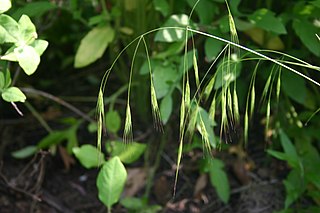
Eragrostis is a large and widespread genus of plants in the grass family, found in many countries on all inhabited continents and many islands.

Polytrias is a genus of Asian, African, and Pacific Island plants in the grass family, commonly called Java grassBatiki bluegrass, Indian murainagrass, or toto grass. The only known species is Polytrias indica, native to West Africa, Seychelles, the Indian Subcontinent, southern China, Southeast Asia, New Guinea, Fiji, and Micronesia. It is also cultivated as a lawn grass in other tropical regions, and naturalized in scattered locations in tropical North and South America.

Agropyron is a genus of Eurasian plants in the grass family), native to Europe and Asia but widely naturalized in North America.

Molinia, or moor grass, is a genus of two species of flowering plants in the grass family, native to damp moorland in Eurasia and northern Africa. They are both herbaceous perennial grasses.

Andropogon is a widespread genus of plants in the grass family, native to much of Asia, Africa, and the Americas as well as southern Europe and various oceanic islands.

Imperata is a small but widespread genus of tropical and subtropical grasses, commonly known as satintails.
Psammochloa is a plant genus in the grass family. The only known species is Psammochloa villosa.
Brylkinia is a genus of East Asian plants in the grass family. The only known species is Brylkinia caudata, native to Japan, China, and Russia.

Schizachne is a genus of Eurasian and North American plants in the grass family. The only accepted species is Schizachne purpurascens, commonly called false melic. Three subspecies are recognized:
Sinochasea is a genus of plants in the grass family. The only known species is Sinochasea trigyna, native to mountainous regions of Tibet, Qinghai, Nepal, Bhutan, Sikkim and Arunachal Pradesh.
Sphaerocaryum is a genus of Asian plants in the grass family. The only known species is Sphaerocaryum malaccense, native to southern China, Indochina, the Indian Subcontinent, Peninsular Malaysia, Philippines, and Sumatra.

Trisetum is a genus of plants in the grass family, widespread in temperate, subarctic, and alpine habitats in much of the world. Oatgrass is a common name for plants in this genus.

Ottochloa is a genus of African, Asian, and Australian plants in the grass family.

Garnotia is a genus of Asian, Australian, and tropical island plants in the grass family. Several of the species are native to Sri Lanka and southern India.
Germainia is a genus of Chinese, Asian and Australian plants in the grass family.

Hackelochloa is a genus of Asian and African plants in the grass family.

Hemarthria is a genus of herbaceous plants in the grass family. They occur in the tropical and subtropical Old World, especially in China and Southeast Asia, with some species in Africa, Australia, and southern Europe. They may be known generally as jointgrasses.

Hygroryza (watergrass) is a genus of Asian plants in the grass family.

Bolboschoenus maritimus is a species of flowering plant from family Cyperaceae. Common names for this species include sea clubrush, cosmopolitan bulrush, alkali bulrush, saltmarsh bulrush, and bayonet grass. It is found in seaside wetland habitats over much of the world. It is widespread across much of temperate and subtropical Africa, Asia, Europe, North America, South America and various islands.
GrassBase is a web-based database of grasses, continually maintained and updated by the Royal Botanic Gardens, Kew.













